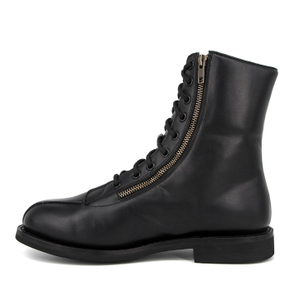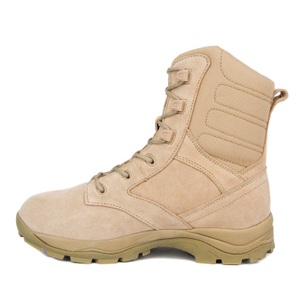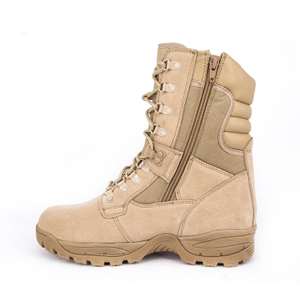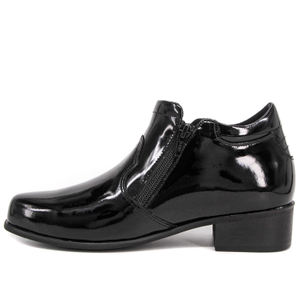When it comes to footwear for outdoor activities, two common choices stand out: military boots and hiking boots. While both types of boots are designed to provide support, comfort, and protection, they are purpose-built for different environments and needs. If you're someone who enjoys hiking, camping, or even works in security or law enforcement, you might be wondering which type of boots are best suited for your needs.
In this article, we will dive into the key differences between military boots and regular hiking boots, highlighting their features, benefits, and the specific roles each type of footwear plays. Understanding these differences will help you make a more informed decision when choosing the right pair of boots for your outdoor adventures or professional tasks.
What Are Military Boots?
Military boots are specialized footwear designed primarily for military personnel, but they are also used by law enforcement officers, emergency responders, and even security guards. These boots are built to withstand demanding conditions such as rough terrain, harsh weather, and long hours of wear.
What Are Regular Hiking Boots?
Regular hiking boots, on the other hand, are designed primarily for outdoor recreational activities such as hiking, backpacking, and trekking. These boots are crafted to offer support and comfort over long distances on uneven terrain, making them ideal for individuals who enjoy nature walks and challenging hikes.
Key Differences Between Military Boots and Hiking Boots
While military boots and regular hiking boots both serve to protect and support the feet, their design and features are optimized for different purposes. Let’s break down some of the major differences:
1. Purpose and Use
The most significant difference between military boots and hiking boots lies in their intended use. Military boots are built for tactical and combat scenarios, providing soldiers and other professionals with the protection and support they need while carrying heavy gear and performing intense physical activities. These boots are engineered to endure extreme environments, including rough terrain, hot deserts, jungles, and cold weather conditions.
In contrast, hiking boots are primarily designed for recreational activities like hiking, trekking, and backpacking. They are made for long walks over moderate to rugged trails, and their primary focus is comfort, stability, and traction on uneven terrain. While hiking boots are tough and durable, they are not built to withstand the same level of stress and extreme conditions as military boots.
2. Durability and Material
Military boots are typically constructed from heavy-duty materials like full-grain leather, ballistic nylon, and rubber. These materials are selected for their durability and resistance to abrasions, which is critical when soldiers are exposed to rough conditions, including crawling, jumping, and navigating through mud, sand, and even water. The boots also feature reinforced soles and heel areas to provide additional protection and prevent wear.
On the other hand, regular hiking boots are often made from a combination of leather and synthetic materials. While hiking boots are durable and capable of handling moderate wear, they don’t typically have the same level of ruggedness as military boots. Hiking boots use lighter materials to reduce overall weight, which is crucial for long hikes. Some models may feature waterproof membranes like Gore-Tex, which help keep the feet dry, but the focus on breathability and comfort is greater than the need for extreme durability.
3. Ankle Support
One of the defining characteristics of military boots is their high ankle support. Military boots are designed to provide stability and protect against ankle sprains, which are common in military operations where soldiers are required to carry heavy packs, move swiftly, or navigate through unpredictable environments. The boots typically rise well above the ankle, offering a secure fit that prevents excessive movement in the foot.
While hiking boots also provide ankle support, they tend to be slightly more flexible and lower cut compared to military boots. Hiking boots are designed to give the wearer greater freedom of movement, which is important when navigating hills, rocks, or narrow trails. However, high-cut hiking boots are available for those who need additional support during particularly challenging hikes or treks.
4. Waterproofing
Waterproofing is another area where military boots often outshine regular hiking boots. Many military boots are designed to be fully waterproof or water-resistant to protect soldiers from wet conditions, including standing water, rain, or wet terrain. Some models include a Gore-Tex membrane or similar waterproof lining to ensure that feet stay dry during operations, regardless of the environment.
Hiking boots, in comparison, are typically water-resistant rather than fully waterproof. They are designed to shed light rain or morning dew, but they may not hold up in extremely wet conditions. However, some high-end hiking boots come with waterproof membranes, which provide added protection when needed.
5. Weight
Military boots are generally heavier than regular hiking boots due to their reinforced construction, additional ankle support, and tougher materials. While this added weight offers durability and protection, it can make the boots feel bulky during extended wear, especially in tactical scenarios.
Hiking boots, on the other hand, are often lighter in weight, making them more comfortable for long-distance walks or multi-day hikes. The lightweight design reduces fatigue and allows for a more natural walking motion. However, lighter boots might not offer the same level of protection and support found in military boots.
6. Comfort and Cushioning
Both military boots and hiking boots are designed for comfort, but their focus differs. Military boots often have additional padding and insoles to provide cushioning during long hours of standing, marching, or walking with heavy equipment. Many military boots also feature shock-absorbing midsoles to reduce the impact on joints during physical exertion.
Hiking boots, while still designed for comfort, typically emphasize foot movement and flexibility. The cushioning in hiking boots is generally softer and more responsive to the varying terrain hikers encounter, which is important for reducing fatigue during long treks. Hiking boots also often have moisture-wicking insoles to keep feet dry and comfortable throughout the day.
Which Boots Are Right for You?
When deciding between military boots and regular hiking boots, the choice largely depends on your needs and the type of activity you plan to engage in.
For Tactical Operations or Law Enforcement: If you work in law enforcement, security, or any other field where you need durable, high-support footwear for unpredictable conditions, military boots are your best bet.
For Hiking and Backpacking: If your primary goal is to hike or backpack over moderate to rough terrain, regular hiking boots will offer more flexibility, comfort, and traction, allowing for longer days on the trail.
For Versatility: Military boots are also versatile and can be used for hiking, especially in extreme conditions. However, if you're mainly focused on recreational outdoor activities, hiking boots are more suitable for most situations.
Conclusion
Both military boots and hiking boots serve distinct purposes and offer unique benefits. Military boots are purpose-built for tactical environments, providing superior protection, durability, and ankle support, while hiking boots are designed for outdoor enthusiasts seeking comfort, flexibility, and traction over long distances. Ultimately, the choice depends on your specific needs and the environment in which you plan to use your boots.
If you're looking for high-quality military boots or tactical footwear for demanding conditions, consider checking out Milforce Equipment Co., Ltd., a trusted manufacturer known for its top-notch tactical gear. Whether you're in the military, law enforcement, or any other field requiring specialized boots, Milforce offers a wide range of footwear designed for comfort, durability, and performance.























